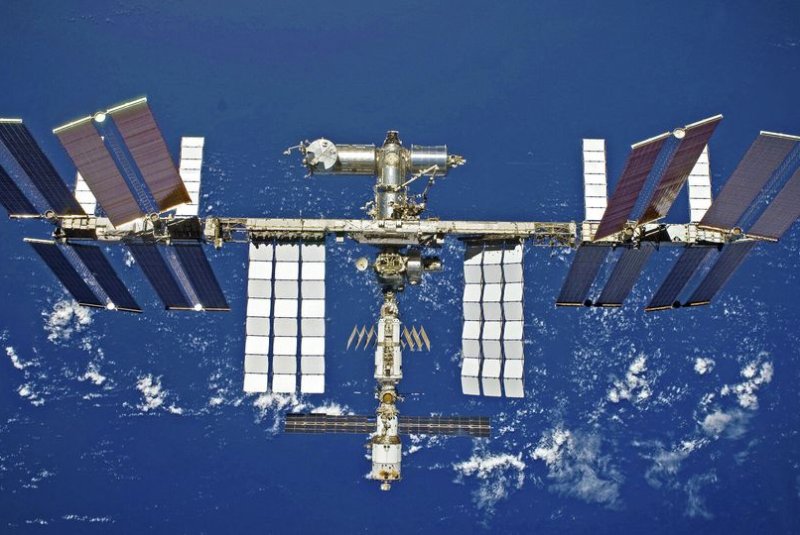DO NOT DROP IT ON OUR HEADS
NASA mulls how to dispose of International Space Station
ORLANDO, Fla., Aug. 12 (UPI) -- A plan to use a Russian spacecraft to deorbit the International Space Station as early as 2028 remains in question because the United States does not know Russia's intentions for using the orbiting laboratory, NASA and other parties involved in the decision say.
A NASA safety panel approved a plan in 2019 that relies on Russia to modify and launch a Progress spacecraft to guide the structure into the atmosphere, where most of it would melt and the rest break up over the Pacific Ocean.
But Russia's agreement with space station partners -- including Europe, Japan and Canada -- ends in 2024, and Russian state media reported in April that the nation's deputy prime minister, Yuri Borisov, said it might abandon it by 2025.
Uncertainty over future Russian participation -- and developing its own space station -- has led to a non-committal stance by NASA, pending more clarity about the deorbit plan and whether Russia still will carry out the job.
"NASA is continuing to work with its international partners to ensure a safe deorbit plan of the station and is considering a number of options," spokeswoman Leah Cheshier said in an email. She would not elaborate on those options.
Chester said the deorbiting mission would be "shared by the ISS partnership and is negotiation-sensitive at this time."
In the meantime, NASA's cost to run the space station has grown to $3 billion to $4 billion annually.
Those familiar with previous negotiations said Russia most likely is posturing to have NASA bear more of the costs for deorbiting the space laboratory.
The space station was projected to have a lifespan of 30 years when Russia and the United States began to launch it in sections in 1998. NASA's Aerospace Safety Advisory Panel, a group of space and engineering professionals, pushed NASA to finalize the deorbit plan by 2019.
"The details of the decommissioning plan are still under discussion with international partners and contain predecisional and non-NASA technical details and are therefore not releasable at this time," the agency said in an email.
An early draft of the deorbit plan dating to 2010 said Russia was to modify a Progress service module, which would use its thrusters to guide the massive platform into the atmosphere starting at its normal speed of about 17,000 mph. That much of the plan is still on the table, NASA confirmed.
The space station would succumb gradually to Earth's gravity and the increased drag from the atmosphere. Friction from the air would heat the 450-ton structure so fast that parts of it would melt quickly. Solar panels would disappear first, while remnants of engines, laboratories and living quarters would fall into the sea.
If a Russian spacecraft isn't used, other spacecraft that could be modified include the SpaceX Dragon, Japanese H-2A or Northrop Grumman Cygnus cargo capsule, according to a study of the decommissioning process by European scientists.
NASA is focused on Northrop Grumman's Cygnus as a possible alternative, Dan Huot, a space agency public affairs officer, said in an interview.
"Cygnus ... is the only other vehicle that we're looking at potentially being used besides the Russian Progress," Huot said.
Having Russia act as the demolition leader would be a matter of trust. Most officials familiar with the plan believe Russia is capable of performing the maneuver, but the uncertainly lies in whether it will -- and do so without a hitch.
One reason for doubt is that Russia's recent activity at the space station was marked by a hair-raising accident when its new science and living module, the Nauka, fired thrusters accidentally July 29.
That knocked the orbiting laboratory out of its normal position and caused it to spin 1 1/2 times before engineers regained control.
To prepare for the space station's ultimate demise, NASA is checking off a list of events that need to occur before it can leave orbit, Patricia Sanders, chairwoman of the safety panel, said in an interview.
"They are doing, step by step, the work that needs to be done. Software has already been updated to optimize ... control during deorbit burns," Sanders said.
"The Russians have agreed in principle to provide the Progress capsule, but there is work that they would have to do, also," she said. "Planning like this is never easy with the space station because we have an international community, so you can't unilaterally decide what to do there."
NASA updates the safety panel at each of its quarterly meetings and will continue until the space station no longer exists, she said.
The last update came on July 15, when Sanders said the arrival of Russia's Nauka "indicates continued commitment of that partner to the station."
At the end of its life, space station parts that survive re-entry would fall into an area of the Pacific known as Point Nemo because it is the oceanic region farthest from land, according to NASA. Warnings would be posted internationally for boats and aircraft to avoid the area at that time.
Astronauts and cosmonauts would prepare the space station for its final flight, trying to ensure it will stay together until the heat of re-entering the Earth's atmosphere can burn up all except the biggest, most massive parts.
"Must drop as deep as possible into the atmosphere in one orbit," the early draft of the plan reads.


No comments:
Post a Comment